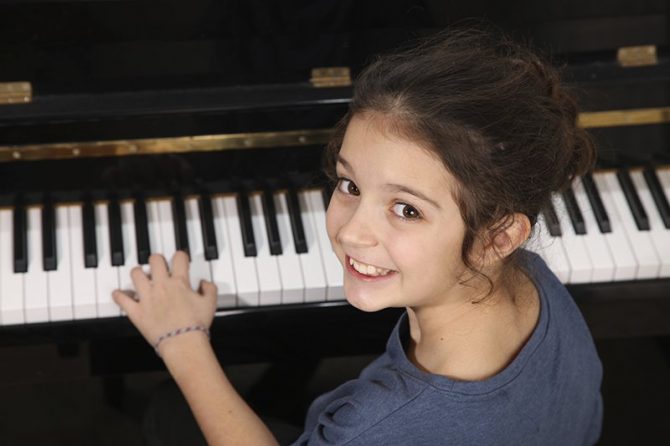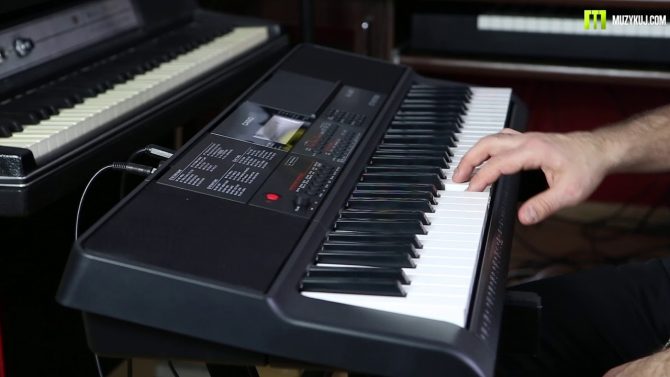
Click image for more details
Casio is in the process of upgrading their popular CTK line of portable keyboards to the new CT-X line. CT-X models feature Casio’s brand new AiX sound source technology for exceptional sound quality, along with Digital Signal Processor (DSP) effects to combine algorithms for the ultimate performance in each instrument sound.
These keyboards also have a registration function that allows users to save different keyboard setups, including tones and rhythms, so they can switch setups without needing to re-configure their settings every time.
Casio CT-X700 Overview

The Casio CTX700 is simply loaded with features. It has 61 full-size, touch-sensitive keys, 600 built-in instrument tones, 195 built-in rhythms, 100 types of arpeggio, 310 music presets, and an onboard library of 160 songs. It also gives players the ability to add their own songs and rhythms, create their own presets, and record and playback their own performances.
An ample array of audio in- and out-puts, along with MIDI standard and USB connectivity, open up a world of accessories, apps, and computer capabilities to go along with this keyboard. It has all the stats and features that beginning and intermediate keyboard players are looking for, in a compact and portable package.
Even better, the AiX sound engine produces fantastic instrument voices with excellent memory handling, with better audio performance and higher quality sound samples than almost any keyboard in this price range. The new Casio CTX line is designed to meet the needs and wants of today’s piano students and aspiring musicians, and the CTX700 is an excellent example.
Video Overview of Casio CT-X700
Here’s a 7-minute video overview by Casio Music Gear.
Casio CT-X700 FAQs
When did the Casio CT-X700 come out?
The Casio CT-X700 come out in 2018.
What are the dimensions of the Casio CT-X700?
The dimensions of the Casio CT-X700 are 13.8 x 37.3 x 4.3 inches.
What is the weight of the Casio CT-X700?
The Casio CT-X700 weighs 9.48 pounds (4.3 kg).
How much does the Casio CT-X700 cost?
The Casio CT-X700 costs around $175 but it can vary depending on where you buy it.
How many keys does the Casio CT-X700 have?
The Casio CT-X700 has 61 Full-Size Touch-Responsive Keys.
How many sounds does the Casio CT-X700 have?
The Casio CT-X700 has 600 sounds presets.
Where can I see a demo/test of the Casio CT-X700?
You can see a demo/test of the Casio CT-X700 here.
Where can I see an unboxing of the Casio CT-X700?
You can see an unboxing of the Casio CT-X700 here.
Where to buy the Casio CT-X700?
The Casio CT-X700 is available in large shops including Amazon.
What music databases come with Casio CT-X700?
The music databases comes with Casio CT-X700 is known as ‘Song Bank’.
Yamaha PSR-E363 vs Casio CT-X700.
The similarities between both models are:
- Both are 61-key keyboards.
- Both models have reverberation and chorus.
- They have maximum polyphony of 48 notes.
- Both have a USB to Host connection so that you can record MIDI tracks by connecting them to a PC or other devices.
- 2.5W speakers. This power is only for listening at home.
- They come with a power supply so they can be connected to the electric current and can be equipped with batteries.
The differences between the models are:
- The Casio CT-X700 has 600 sounds presets and Yamaha PSR-E363 has 574 sounds presets.
- The CT-X700 features 160 pre-recorded songs and the PSR-E363 154 demo songs.
- In the case of the Casio CT-X700 we find 195 different rhythms and in the Yamaha PSR-E363, 165 different styles.
- Yamaha PSR-E363 has one-touch setting function and metronome but The Casio CT-X700 doesn’t have one-touch setting function and has lessons practice feature.
- The Yamaha offers to record up to 5 user songs (which you can create and record yourself). This is not possible with the Casio.
- Duo function of the Yamaha PSR-E363: Allows the keyboard to become two different keyboards, so that it can be played by two people at once, such as a teacher and a student.
- Casio CT X700 has Output Line connection. It has more power to connect to powerful sound equipment. It makes sense at big gigs.
- Casio CTK-800: Weight 4.3 kilos and dimensions (width x depth x height) 948 x 350 x 109 mm. Yamaha PSR-E363: Weight 4.6 kg and dimensions (width x depth x height) 945 x 368 x 118 mm.
Casio CT-X700 vs CT-X3000
The similarities between both models are:
- They have same numbers of keys (61) and same levels of touch sensitivity.
- They have same tune generator.
- Both models have 17 scale setting presets.
- They have same set of connections except CT-X3000 has 2 pedal instead of 1.
The differences between two models are:
- Casio CT-X700 has maximum polyphony of 48 notes but CT-X3000 has 64.
- The Casio CT-X700 has 600 sounds presets but CT-X3000 has 800 sounds presets.
- The Casio CT-X700 has 195 rhythm presets and CT-X3000 has 235 rhythm presets.
- The CT-X700 features 160 pre-recorded songs but CT-X3000 has 30 songs presets.
- The Casio CT-X700 6 tracks in MIDI recorder but CT-X3000 has 17 tracks in MIDI recorder.
- The Casio CT-X700 has 4.7″ x 2 speakers and 5W amplifiers. CT-X3000 has 3.9″ x 2 speakers and powerful 12-watt stereo speaker system.
- CT-X3000 consumes more power compared to The Casio CT-X700. CT-X3000 has 6 x D batteries and The Casio CT-X700 has 6 x AA batteries.
- CT-X3000 has a dimensions of 37.3″ x 15.1″ x 4.6″ and weighs 15.2 pounds. The dimensions of the Casio CT-X700 are 13.8 x 37.3 x 4.3 inches and weighs 9.48 pounds.
- CT-X3000 costs more than $ 100 compared to Casio CT-X700.
Specifications of Casio CT-X700
|
Specification |
Description |
|---|---|
|
Keys |
61 full-size keys |
|
Touch Sensitive Keys |
3 levels of touch sensitivity, or turn touch sensitivity off |
|
Built-in |
|
|
Presets |
|
|
Polyphony |
48 max levels of polyphony |
|
Songs |
|
|
Functions |
|
|
Jacks & Ports |
|
|
Power |
Can be powered with AC cord or 6AA batteries |
Who the Casio CT-X700 Keyboard is Most Suitable For?

The Casio CTX700 is an excellent choice for a committed beginner. It has onboard learning and lesson capabilities, and keyboard functions to make it easy to learn the piano, and can also be used with a wide range of piano education apps. The sheer number of features, and the need to refer to the manual to configure many of the options and settings, make it a less suitable choice for young children, or people who just want to mess around with a keyboard.
This Keyboard is particularly good for committed beginners because these capabilities, features, and customization options are rich enough to continue to engage intermediate and even advanced keyboard players. It has the musical capacity to remain a valuable instrument for years of learning, rather than being a keyboard that a beginner will quickly “graduate” from.
It’s also a great choice for more advanced keyboard players who need a more lightweight, portable instrument. The ability to customize settings, songs, and rhythms, and quickly store and retrieve presets, along with audio output capabilities, make this a good choice for small gigs and rehearsals, composing or experimenting on the road, or even from the couch.
What’s Included In the Box of Casio CT-X700?

The Keyboard comes with the necessary power supply.
Features of Casio CT-X700

|
FEATURE |
DESCRIPTION |
|---|---|
|
Design |
It has 61 full size, touch-sensitive keys that help players learn the hand positions necessary to play on a full-size 88 key or acoustic piano keyboard. Touch sensitivity reacts to the speed and pressure as you play, increasing the volume accordingly. These keys aren’t weighted, however, so the fingers won’t develop the same strength or technique necessary to transition smoothly to an acoustic piano. |
|
Sound |
The AiX sound engine and DSP processing provides excellent instrument tones and voices not just in the piano instruments, but enhances the sound of strings, brass, wind instruments, and even effects, for excellent sound quality and appealing tones across all the capabilities of the keyboard. |
|
Keyboard layer functions |
Keyboard layer functions allow you to play two instrument tones simultaneously with each key, while keyboard split functions allow you to play two different instrument voices with each hand.With all these options and settings, it can be a bit frustrating to need to frequently refer to the manual to explore and experiment with different options, but the ability to choose from one-touch presets, and store your own settings into registration memory will ease that process and make it faster over time. |
|
Functions |
X700 has a rich library of instrument voices, built-in rhythms, music and accompaniment styles. It also has a broad range of reverb, chorus, harmony, and other effects for customizing the instrument sound. |
|
Education |
The keyboard also has a number of features to help beginners learn to play the piano. The Casio Step-up lesson system teaches songs phrase-by-phrase, chord-by-chord, or hand-by-hand, at your own pace, depending on how you prefer to practice. It has a melody suppression system that allows you to not only play the lead role in any song in the onboard music library, but can also suppress the memory of songs played through the audio input, so you can play along with all your favorites. |
|
Features |
GM level 1 MIDI format and USB capacity are a great advantage in this keyboard. It allows you to pair the keyboard with tablets and devices, augmenting your ability to learn, record, mix, and share music online. The ability to add and store your own custom rhythms and songs, and record and playback your own songs on the keyboard, help with both learning and with performance. |
Pros & Cons of Casio CT-X700
|
PROS |
|---|
|
|
cons |
|---|
|
Casio CTX-X700 Manual
If you’d like to check out the nitty-gritty of the Casio CTX-X700, here’s a link to the model’s manual:
CLICK TO DOWNLOAD CASIO CTX-X700 MANUAL
An Alternative Product to Consider: Casio CT-X700 vs Yamaha PSR-E363

From the similarity between the devices, one might suspect that the Casio CTX line is aimed to compete with the popular Yamaha PSR line of keyboards. The Casio CT-X700 is extremely similar to the Yamaha PSR-E363. Both keyboards have:
- 61 touch-sensitive keys
- LCD displays
- Battery power capacity
- 48 levels of polyphony
- Keyboard layer and split functions
- Melody suppression
- Pedal and audio inputs
- Metronome
- Tempo, transpose, and tuning controls
- One-touch piano button
- Onboard lesson tools
- Registration functions
- USB capability
The Yamaha PSR-E363 has a few advantages over the Casio CT-X700:
- 26 types of harmony vs 12
- 150 types of arpeggio vs 100
- 9 slots of registration memory vs 4
- Duo keyboard function (virtually splits the keyboard in half, so two players can play side-by-side)
And the Casio CT-X700 has some clear advantages over the Yamaha PSR-E363:
- It has 195 built-in rhythms
- It uses MIDI recording rather than a proprietary file format
- It has the ability for users to create, store, and retrieve custom rhythms and add songs to the onboard library.
- It comes with the necessary AC power adaptor
However, the Casio CT-X700 simply has more capacity than the Yamaha PSR-E363:
- 600 instrument voices vs 574
- 20 types of reverb vs 12
- 10 types of chorus vs 5
- 6 types of master EQ
- 310 music presets vs 165
- 160 songs vs 154
- Capacity for 6 user-recorded songs instead of 5
While the Yamaha AWM sound engine is very good for a beginner piano, there is no doubt that the Casio AiX sound engine is an improvement. Ultimately, the Casio CT-X700 simply sounds better than the Yamaha, and has more features, for the same price.
While it is still hard to find, it may also be worth looking at a Casio CT-X800. It has all the features of the CT-X700, along with a little more memory, improved two-way USB connectivity, and a pitch bend wheel for just a slightly higher purchase price.
Video: Casio CT-X700 Grand Piano Sounds
Video: Sam Ash Music’s CT-X700 Review
Conclusion
Casio’s CTX line is precisely aimed at the features, functions, and capabilities that beginner and intermediate musicians are looking for in a portable keyboard. X700 has a great sound, robust construction, rich feature set, and expansion capabilities to be the only keyboard you need for years to come.

It also has the advanced digital features that acoustic pianos don’t have, including a wide selection of tones, rhythms, polyphony, and even simple volume controls to make it easy to live with.
Recording and playback, transpose, and split keyboard functions offer a range of possibilities and capabilities that invite learning and exploration, as well as affording unique opportunities for growth and expression.
Most keyboards offer a fraction of the features at more than double the cost. This powerful, versatile, handsome digital console keyboard simply cannot be beat in its price range, and is a fantastic choice for piano lovers everywhere.
